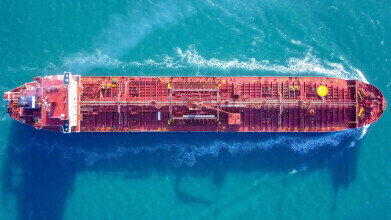Fuel for Thought
Back to the Future: are modern airships and sailboats the transport of tomorrow?
Nov 01 2023
At PIN, we talk a lot about the next generation of green fuels for combustion engines – but what possibilities open up to us if we consider combining these new sources with renovated traditional tech, like dirigibles and sails? Innovators in the transport and logistics sectors are looking towards the past for inspiration, prompting a surprising but sensible resurgence: the comeback of airships and sail-powered vessels.
Often considered a relic from the early 20th century, airships are making an unexpected return. Unlike airplanes, modern airships create a significantly lower environmental footprint, offering a form of travel that's almost entirely decarbonized. These vessels, sometimes referred to as "sky whales," are a far cry from their ancestors, with advancements addressing many earlier vulnerabilities, including safety, speed, and durability.
Primarily, the contemporary appeal of airships lies in their eco-efficiency. They require less energy, owing to their buoyancy, and recent models are proposed to be powered by hydrogen or solar energy, making high-altitude, long-distance travel possible without the heavy carbon cost of traditional airlines. This advantage is particularly poignant in the current environmental crisis, as reducing emissions in all sectors, including aviation, is paramount.
Moreover, airships offer unique benefits in logistics, especially in hard-to-reach areas. With the ability to land almost anywhere, they could revolutionize transport to remote regions, providing essential supplies without the need for carbon-intensive infrastructure projects like roads or airports, and without the associated environmental disruption and carbon emissions of contemporary air travel.
However, challenges remain, including securing investment and navigating strict air travel regulations, which are currently more suited to traditional aircraft. These barriers notwithstanding, the potential of airships in a green economy is boundless, and with further research and development, they could become a common sight in our skies – indeed, as they make such little noise, they’d only be a sight.
In the immediate future, a rapid acceleration of this form of transport could eliminate the need for domestic flights, whilst putting pressure on organisations to invest in domestic high-speed rail and in modern sail-powered sea travel as a competitor to long-distance, intercontinental flights.
Parallel to the skies, the seas are also witnessing a transformative kind of revival. Sail-powered shipping, once rendered obsolete by steam and diesel-powered ships, is on the brink of a major comeback. This resurgence is driven by the urgent need to mitigate the shipping industry's substantial carbon emissions, responsible for about 3% of global totals, and the sector's broader environmental impact.
Modern sailing vessels combine traditional principles with new technology. Automated, efficient sail systems harness wind power, reducing reliance on fossil fuels while maintaining, and at times surpassing, the speed and reliability of some conventional ships. Designs incorporating solar panels or hybrid engines provide additional green energy sources, ensuring functionality even in low-wind conditions.
Beyond environmental benefits, sail-powered ships have economic appeal. As fuel prices rise and green regulations tighten, wind becomes an attractive, cost-efficient power source. Moreover, these ships are likely to receive favour in carbon credit schemes, providing economic incentives to operators and further integrating sustainability into the economic fabric of shipping.
Admittedly, the transition isn't without its hurdles. Retrofitting existing vessels or building new ones requires substantial investment, while global logistics chains, built around speed and predictability, may initially struggle to adapt. However, with continued innovation and investment, sail-powered shipping has the potential to become a cornerstone in the sustainable movement of goods.
The re-emergence of airships and sail-powered shipping represents more than a nod to the past; it's a strategic re-envisioning of the future of transportation. These modes are not without challenges, from technological hurdles to economic recalibrations, yet they hold immense promise for a sustainable economy. As we aim to reconcile economic progress with environmental stewardship, such innovative revivals offer a unique opportunity to navigate towards a greener, more responsible world. The course is set, and the winds of change are favourable; it is up to us to innovators in the industry to seize this momentum and sail forth.
Digital Edition
PIN 25.2 Apr/May
April 2024
In this Edition Safety - Carbon monoxide toxic and flammable gas detection Analytical Instrumentation - Density: A fundamental parameter at critical stages within the petroleum sector...
View all digital editions
Events
May 06 2024 Riyadh, Saudi Arabia
May 06 2024 Houston, Tx, USA
May 06 2024 Houston, Tx, USA
Canada Gas & LNG Exhibition & Conference
May 07 2024 Vancouver, BC, Canada
May 08 2024 Lahore, Pakistan


















